Table of Contents
Q1. A manufacturer manufactures phone. While manufacturing he incur two types of cost – Fixed cost & variable cost. His total fixed cost is Rs.‘x’ annually and he can produce only 1,00,000 units in an year. If he produces 60,000 units, his per unit cost is Rs.9 and if he produces 1,00,000 units, his per unit cost is Rs.7.40. Then, find at what price per unit he should sell 80,000 units, if he wants to earn 20% profit.
(a) Rs.8.4
(b) Rs.8
(c) Rs.9.6
(d) Rs.10
(e) None of the above.
Q2. A man has two items A and B. What is the selling price of item B?
(A) The amount obtained after selling 4 of item A and 1 of item B is Rs. 70. From this amount he either could buy 7 of item A or 1 of item A with 4 of item B.
(B) Profit earned on selling 1 of item B is Rs. 3 and profit % earned on selling 1 of item A is 30 %. Selling price and cost price of item B are Rs. 5 greater than that of item A respectively.
(C) Ratio of profit % earned on A and B is 3 : 2 and ratio of their cost price is 2 : 3 respectively. All profit % , cost price and selling price have integer value.
(a) Either A and B or B and C are sufficient to answer the question
(b) Either A and B or A and C are sufficient to answer the question
(c) Either A and C or B and C are sufficient to answer the question
(d) A, B and C together are sufficient to answer the question
(e) Either only B or A and C together are sufficient to answer the question
Q3. Selling price of two articles is same and shopkeeper claim to get 20% profit on each article but mistakenly he calculates one profit on selling price. If difference of profit he gets on articles is 8 Rs. then find the selling price?
(a) Rs.200
(b) Rs.180
(c) Rs.160
(d) Rs.220
(e) Rs.240
Directions (4-5): A shopkeeper gives a 20% discount on MRP on each ball and if someone bought 45 balls at discounted price, he will also get 15 balls free. Even after selling balls 60 balls on the price of 45, shopkeeper earns 20%.
Q4. Find ratio of MRP of 1 ball to CP[for shopkeeper] of 1 ball.
(a) 2 : 1
(b) 5 : 1
(c) 10 : 1
(d) 3 : 1
(e) 4 : 1
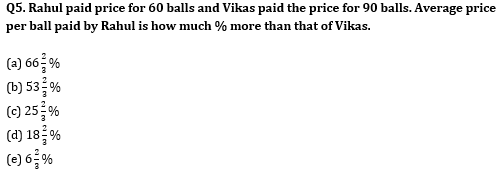
Q6. Ajay and Vijay entered into a partnership business and invested Rs.7000 and Rs.15000 respectively. After 4 months, Ajay invested Rs.5000 more and after 7 months, Vijay withdraws Rs.5000. Ajay is entitled to 10% net profit as salary and remaining net profit is distributed (40% in the ratio of their capitals and 60% in the reverse ratio of their capitals). If profit share of Vijay at the end of the year is Rs.44000, then find profit share of Ajay at the end of the year.
(a) Rs.61000
(b) Rs.56000
(c) Rs.46000
(d) Rs.51000
(e) None of the above.
Directions (7-8): A & B entered into a business by making investment of Rs. 7200 and Rs. 9600 respectively. After six months A & B both added amount in the ratio of 7: 10. (Business in which A & B entered last for total 12 months)?
Q7. If Satish & Veer invested equal amount as A & B invested for last six months respectively and both Satish and Veer invested for equal time period. Veer got Rs. 25500 as profit share out of total profit of Rs. 44250, then find the amount that A & B invested for last six months in business.
(a) Rs. 8000 & Rs. 9600
(b) Rs. 6000 & Rs. 7200
(c) Rs.10000 & Rs. 13600
(d) Rs.9600 & Rs. 10800
(e) Rs.7800 & Rs. 8800
Q8. P & Q entered into business by making investment of Rs. 2000 & Rs. 1400 more amount respectively than the amount which A & B invested in second half of business. If at the end of year P & Q got profit in the ratio of 4: 5, then find the difference between investment of P & Q. Given that both P & Q invested for equal time period.
(a) Rs. 2400
(b) Rs. 3000
(c) Rs. 3600
(d) Rs. 2800
(e) Rs. 3200
Q9. A and B entered into partnership business. A invested Rs. P and B invested 40% more than A and each of A & B invested for eight months. After four months from starting of business, C joined them with the amount equal to amount invested by A & B together for four months and they got a total profit of Rs. 14400. Find 80% of profit share of A.
(a) 4800 Rs.
(b) 2400 Rs.
(c) 2000 Rs.
(d) 1600 Rs.
(e) 3200 Rs.
Q10. Maanik and Shivam entered into a partnership by investing Rs.20000 and Rs.32000 respectively. After 4 months, Maanik increased his investment by 50% and after another 6 months Shivam increased his investment by 25%. If at the end of the year Shivam got a profit of Rs.30000, then find total profit?
(a) Rs.80000
(b) Rs.77000
(c) Rs.54000
(d) Rs.93000
(e) Rs.12000
Q11. In a liter of spirit-alcohol solution, 60% is spirit. Some quantity of alcohol is added such that it constitutes 5/8 th of the solution thus formed. What quantity of spirit should be added in that solution so that its final quantity becomes equal to that of alcohol in the final solution?
(a) 300 ml
(b) 400 ml
(c) 450 ml
(d) 420 ml
(e) None of these
Directions (12-13): Two liters of mixture A is added to 3 liters of mixture B with ½ liters of water. Mixture A contains 12% water and mixture B contains 93% of wine and 7% of water.
Q12. Find the ratio of water and wine in new mixture if A contains only wine and water.
(a) 19 : 91
(b) 21 : 12
(c) 31 : 13
(d) 12 : 21
(e) 91 : 19
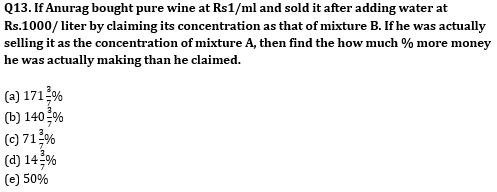
Directions (14-15): Three milkman P, Q and R have mixture of milk and water in the quantity of (X + 24)liters,(X+54)liters and (X+ 84)liters and milk and water in the ratio of 2 : 3, 8 : 7 and 13 : 5 respectively.
Q14. If P sold 50 liters of his mixture and 8 liters of milk added in remaining mixture, new ratio of milk and water becomes 6 : 7 . What quantity of water should be added by Q and R, so new ratio of their mixture becomes 5 : 7 & 5 : 4 respectively ?
(a) 56 liters& 40 liters
(b) 54 liters& 42 liters
(c) 50 liters& 30 liters
(d) 60 liters& 50 liters
(e) 64 liters& 30 liters
Q15. Q sold 40% of his mixture and R sold 50% of his mixture, remaining mixture of both became equal. If all three charge Rs. 2 for one liter of water and production cost of milk for P, Q and R in the ratio of 5 : 6 : 7 and total mixture, which all three milkman have cost Rs. 3644. Find production cost of milk per liter for P, Q and R respectively?
(a) 5 Rs. 6 Rs & 7 Rs.
(b) 25 Rs. 30 Rs & 36 Rs.
(c) 10 Rs. 12 Rs & 16 Rs.
(d) 10 Rs. 12 Rs & 14 Rs.
(e)10 Rs. 14 Rs& 15Rs.
Practice More Questions of Quantitative Aptitude for Competitive Exams:
Solutions
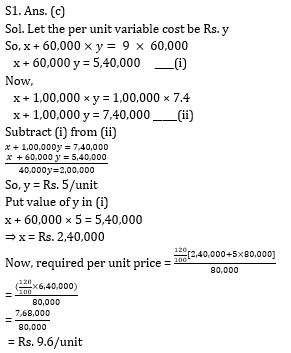
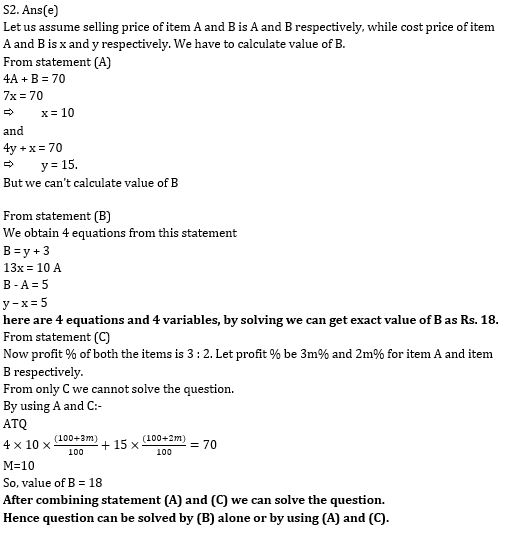
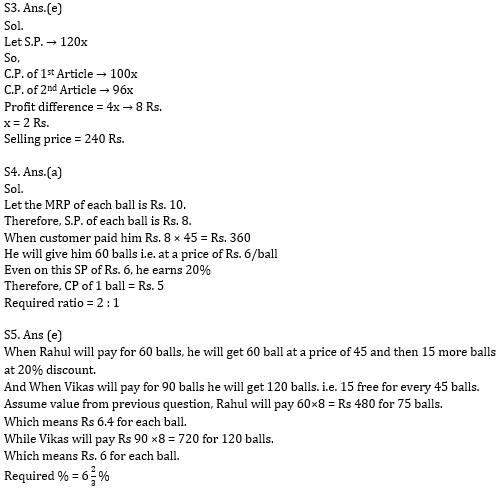
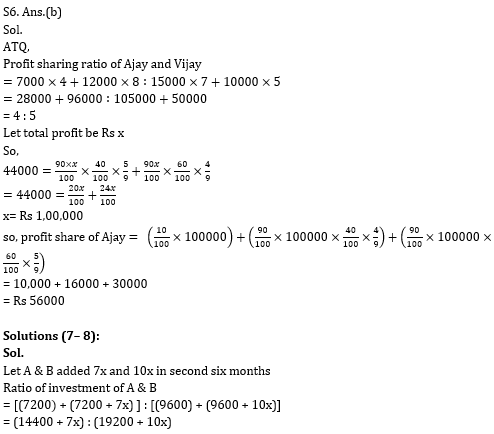
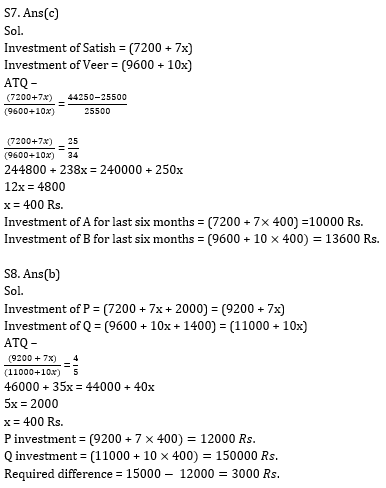
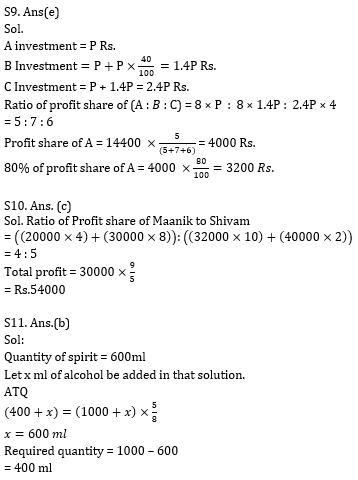
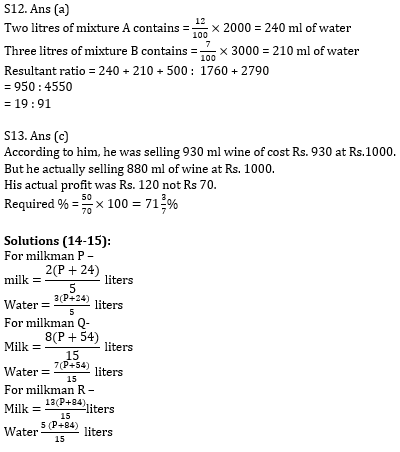
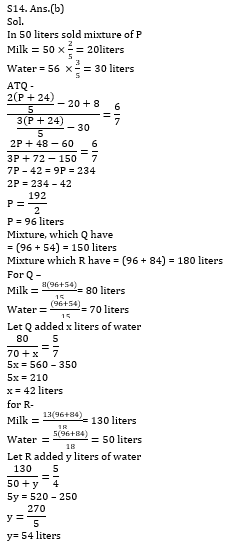
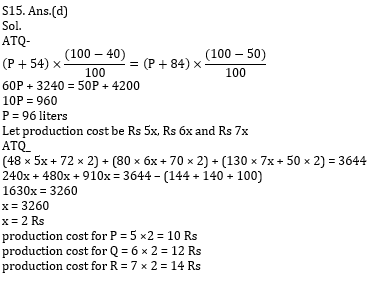
Practice with Crash Course and Online Test Series for IBPS PO/RBI Assistant 2020:
- RBI Assistant Mains 2020 Online Test Series
- IBPS PO Online test series (Prelims + Mains) 2020 by Adda247
- IBPS KA MAHAPACK Online Live Classes




 GA Capsule for SBI Clerk Mains 2025, Dow...
GA Capsule for SBI Clerk Mains 2025, Dow...
 The Hindu Review October 2022: Download ...
The Hindu Review October 2022: Download ...
 ECGC PO Scorecard 2025 Out, Check Marks
ECGC PO Scorecard 2025 Out, Check Marks




